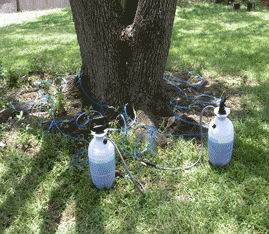Oak Wilt Disease
Management
There are currently three primary approaches used for Oak Wilt
management in Austin, Texas. Successful control usually depends on a integrated
program incorporating measures from all three.
The first approach attempts to prevent the formation of new Oak Wilt
infection centers by eliminating diseased Red Oaks.
The second approach involves trenching or other measures to disrupt root
connections responsible for the transmission of the pathogen.
The third approach is the injection of the Fungicide Alamo, into
individual, high value trees. We recommend injections using Macro-infusion
technology. These measures will not cure Oak Wilt, but will significantly reduce tree
loses.
Infected Red Oaks that die in late summer or fall should be cut and
burned, or buried by early Fall or as soon
after discovery as possible. This will prevent insects from transmitting
the spores from fungal mats that may
form in the Spring. If this is not possible, the trees should be
injected with herbicide or deeply girdled with an ax
and stripped of bark 2 to 3 foot above the soil line. Drying of the wood
before fall discourages formation of fungal
mats.
All pruning during times of high probability of fungal mat formation or
in areas of known Oak Wilt infestation,
should be left to professional arborist.
 Most Oaks develop mechanical problems which cause self inflicted
wounding. This includes interlocking limbs,
Most Oaks develop mechanical problems which cause self inflicted
wounding. This includes interlocking limbs,
branches rubbing on roofs or other structures and other non-phototropic
trees growing up into and through the
crown of susceptible Oaks.
Therefore, most
unpruned Oaks are more likely to become infected by an
insect vector if the fungal mat is nearby.
Regardless of season, all pruning cuts, or other wounds to Oak trees,
including freshly cut stumps and
damaged surface roots, should be treated immediately with a wound
paint to prevent infestation by insect
vectors.
Transporting unseasoned firewood from diseased Red Oaks is the number
one way that the pathogen is
spread from area to area. Oak Wilt can not be spread by burning infected
firewood, but fungal matts can
form on firewood in storage. No vectors of any type have been proven to
transmit the Oak Wilt fungus from
Live Oaks. Transmission is from Red Oaks only. No Oak wood of any type
should be stored near healthy
trees, without taking proper precautions. This includes, purchasing only
seasoned, dry wood and covering
all stored wood with clear plastic, with the edges buried. This is to
prevent insect travel, to or from the
stored wood.
